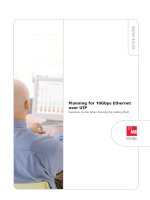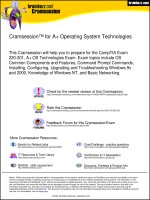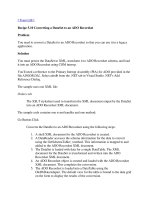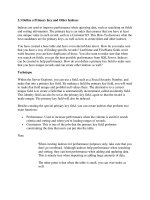Tài liệu POSSUM: a scoring system for surgical audit docx
Bạn đang xem bản rút gọn của tài liệu. Xem và tải ngay bản đầy đủ của tài liệu tại đây (629.41 KB, 6 trang )
Br.
J.
Surg.
1991,
Vol.
78,
March,
356-360
POSSUM:
a
scoring system
for
surgical audit
POSSUM,
a Physiological and Operative Severity Score for the
enumeration
of
Mortality and morbidity, is described. This system has
been devised from both a retrospective and prospective analysis and the
present paper attempts to validate it prospectively. Logistic regression
analysis yielded statistically sign ficant equations for both mortality and
G.
P.
Copeland,
D.
Jones
and
M.
Walters
Department
of
Surgery,
Broadgreen Hospital, Thomas
Drive, Liverpool
L
14
3LB,
UK
morbidity (P
<
0.001).
When displayed graphically zones
of
increasing
morbidity and mortality rates could be defined which could be
of
value
in
surgical audit. The scoring system produced assessments for morbidity
Correspondence to:
Mr
G.
P.
Copeland
rates.
and mortality rates which did not significantly differ from observed
While data regarding the access
of
patients to care and outcome
(presented as overall mortality and morbidity rates) are
relatively easy to derive, ‘quality
of
care’ has proved a more
elusive determinant. In most hospitals, quality of care is assessed
by discussion of individual cases or by review
of
series
of
patients
undergoing particular types of surgical procedure. Comparisons
between different surgeons, units, hospitals and regions are
bedevilled by differences in patient presentation, general fitness
of the local populace and the nature
of
the surgery undertaken.
The Royal College
of
Surgeons
of
England has defined audit
as the ‘systematic appraisal
of
the implementation and outcome
of any process in the context
of
prescribed targets and
standards”. The difficulty in this definition rests in the
interpretation
of
prescribed targets and standards, and it infers
that outcome for individuals and series
of
patients can be
predicted. In this context morbidity is probably as important as
mortality, certainly when discussing quality
of
care. Perhaps
of parallel importance in audit is the discussion
of
individuals
in whom death
or
complications could have been expected, but
did not occur. Thus audit should include discussion
of
‘surgical
success’, in addition to mortality and morbidity rates, if it is
to be educational.
The ideal scoring system for surgical audit purposes should
assess mortality and morbidity and should allow audit retrieval
of the surgical success. It should be quick and easy to use and
should be applicable to all general surgical procedures in both
the emergency and elective setting. It should be
of
use in
all
types of hospital and should provide educational information.
Finally it should be possible to integrate the scoring system
into pre-existing audit programmes with the minimum
of
disruption.
There are many scoring systems that predict the risk
of
mortality with varying degrees
of
accuracy. However, morbidity
is almost universally ignored. Many scores have been devised
which are ideally suited to special types
of
surgical procedure
or to assessing particular types of complication. Some scores
are ideal for assessing the risk of mortality and to
a
lesser extent
morbidity in particular groups
of
surgical patients, such as
those with cardiova~cular~~~ and gastrointestinalL8 disease, or
for assessing the risk of developing particular
complication^^^^^.
Others are
of
use in particular surgical settings, such as patients
requiring intensive care””’. Probably the best known and
most widely used scoring system
is
APACHE
I1
which is ideal
for the intensive care patient but requires 24 h
of
observation
and weighting tables for individual disease states”. Whereas
such a score can be applied to the majority of general surgical
patients it only assesses the risk of mortality. Theoretically the
smaller the number of variables the easier the scoring system.
Indeed some systems have reduced the number
of
variables to
two (age and lymphocyte count
13)
but this reduction clearly
has disadvantages if one factor is not available. Other scoring
systems have reduced variables by multifactorial analysis and
have derived complex mathematical equations to assess the
risk of mortality, but few surgeons carry calculators in everyday
practice.
We identified the need for
a
simple scoring system that could
be used across the general surgical spectrum, whose main use
would be in surgical audit. Our present system has been in
development over the past
2
years. Initially 62 individual factors
(48 preoperative factors and 14 operative and postoperative
factors) were assessed by
a
multivariate discriminant
retrospective analysis over a 6-month period, to reduce the
number
of
variables.
Of
these,
35
factors were assessed
prospectively for
a
further
6
months to produce the present
scoring system. In this later prospective analysis all variables
were subjected to multivariate discriminant analysis and, using
this linear discriminant techniq~e’~, multivariate discriminant
function coefficients were obtained for each set
of
variables.
Only significant independent factors were included in the final
score design. The multivariate discriminant function coefficients
of those remaining factors were divided by a constant and
rounded to the nearest whole number to derive a point value
on an exponential score
(1,
2, 4,
8)
for the variable. Thus a
12-factor, four-grade, physiological score was developed. Any
decrease in score variables below this level resulted in
a
loss
of
predictive ability for mortality
or
morbidity. While this
preoperative physiological score yields
a
statistically predictive
risk
of
morbidity and mortality for the patients overall, there
were intergroup differences depending on the nature
of
the
surgical procedure. Logistic regression analysis
of
all data
enabled
a
six-factor, surgical, operative severity score to be
evolved which compensated for the type
of
surgical procedure.
In the present prospective study we have applied this dual
scoring system to
all
patients admitted during a 6-month period,
equivalent to
our
periods
of
previous study. During this period
the present POSSUM (Physiological and Operative Severity
Score for the enumeration of Mortality and morbidity) system
has been assessed.
Patients and methods
During the
6
months from August
1988
to February 1989 all patients
admitted for inpatient surgery were scored using the POSSUM system
at
Walton Hospital, Liverpool.
In
all,
1440
patients underwent elective
or
emergency surgery during this period and required inpatient care
for
at least
24
h after operation. Patients undergoing surgery for trauma
(12
patients) and those in whom no outpatient review at
6
weeks was
available
(56
patients) were excluded. Thus
1372
prospectively scored
patients were available for study.
All patients were scored before operation (using the physiological
score) and at discharge (using the operative severity score). The
physiological score reflects the indices at the time of surgery rather than
at the time of admission. All patients had
blood
samples taken for
determination of urea and electrolyte levels, haemoglobin concentration
-
0007-1
323/91/03035546
0
1991
Butterworth-Heinemann
Ltd
355
Surgical audit:
G.
P.
Copeland et al.
Table
1
Physiological score
(to
be scored at the time ofsurgery)
Score
Age (years)
Cardiac signs
Chest radiograph
Respiratory history
Chest radiograph
Blood pregsure (systolic)
(mmHg)
Pulse (beats/min)
Glasgow coma score
Haemoglobin (Silo0 ml)
White cell count
(x
10'*/1)
Urea
(mmol/l)
Sodium
(mmol/l)
Potassium
(mmol/l)
Electrocardiogram
1
2 4
8
6
60
No failure
61-70
Diuretic, digoxin, antianginal
or
hypertensive therapy
No dyspnoea
110-130
50-80
15
13-16
410
<
7.5
2
I36
3.5-5.0
Normal
Dyspnoea on exertion
Mild COAD
10&109
81-100
a9
12-14
11.5-12'9
16.1-1 7.0
10.1-20.0
3.140
7.6-1
0.0
131-135
131-170
3.2-3.4
5.1-5.3
271
Peripheral oedema;
warfarin therapy
Borderline cardiomegaly
Limiting dyspnoea
(one flight)
Moderate COAD
2
171
9e99
101-120
9-1 1
10.0-11.4
17.1
-
18.0
220.1
6
3.0
10.1-1 5.0
126130
2'9-3.1
5.4-5.9
Atrial fibrillation
(rate
6&90)
Raised jugular venous
pressure
Card i
o
m
e g a
1
y
Dyspnoea at rest
(rate
>
30/min)
Fibrosis
or
consolidation
-
<
89
2
121
<
39
68
69.9
2
18.1
2
15.1
<
I25
<
2.8
>
6.0
Any other abnormal rhythm
or
2
5
ectopics/min
Q
waves or
ST/T
wave
changes
COAD, chronic obstructive airways disease
Table
2
should be selected)
Operative severity score. (Definitions
of
surgical procedures with regard
to
severity are guidelines; not all procedures are listed and the closest
Score
1
2 4 8
Operative severity* Minor Moderate Major Major
+
Multiple procedures
1
2 >2
Total blood loss
(ml)
<
100 101-500 501-999
2
1000
Peritoneal soiling
None Minor
(serous
fluid) Local pus
Free
bowel content, pus
or
blood
Presence of malignancy
None Primary only
Nodal metastases Distant metastases
Mode of surgery Elective
Emergency resuscitation Emergency (immediate surgery
of
>
2
h possiblet
Operation
<
24
h after
admission
<2
h needed)
*
Surgery of moderate severity includes appendicectomy, cholecystectomy, mastectomy, transurethral resection of prostate; major surgery includes
any laparotomy, bowel resection, cholecystectomy with choledochotomy, peripheral vascular procedure
or
major amputation; major
+
surgery
includes any aortic procedure, abdominoperineal resection, pancreatic
or
liver resection, oesophagogastrectomy; indicates that resuscitation is
possible even if this period is not actually utilized
and white cell count, and all had electrocardiography performed. A
chest radiograph was obtained in
69.7
per cent of patients.
Scores were awarded according to
Tables
I
and
2.
Complications
were recorded on a separate sheet
(Table
3).
For
the purposes of study the following definitions were used:
Wound haemorrhage:
local haematoma requiring evacuation
Deep haemorrhage:
postoperative bleeding requiring re-exploration
Chest infection:
production
of
purulent sputum with positive
bacteriological cultures, with
or without chest radiography changes
or
pyrexia,
or
consolidation seen on chest radiograph
Woundinfection:
wound cellulitis
or
the discharge ofpurulent exudate
Urinary infection:
the presence of
z
lo5
bacteria/ml with the presence
of white cells in the urine, in previously clear urine
Deep infection:
the presence of an intra-abdominal collection confirmed
clinically or radiologically
Septicaemia:
positive blood culture
Pyrexia of
unknown
origin:
any temperature above
37°C
for more than
24
h occurring after the original pyrexia following surgery (if present)
had settled, for which no obvious cause could be found
Wound dehiscence:
superficial
or
deep wound breakdown
Deep venous thrombosis and pulmonary embolus:
when
suspected,
confirmed radiologically by venography
or
ventilation/perfusion
scanning,
or
diagnosed at post mortem
Cardiac failure:
symptoms
or
signs
of
left ventricular
or
congestive
cardiac failure which required an alteration from preoperative
therapeutic measures
Impaired renal function:
arbitrarily defined as an increase
in
blood urea
of
>
5
mmol/l
from preoperative levels
Hypotension:
a fall in systolic blood pressure below
90
mmHg for
more
than 2 h as determined by sphygmomanometry
or
arterial pressure
transducer measurement
356
Br.
J.
Surg.,
Vol.
78,
No.
3,
March 1991
Surgical audit:
G.
P.
Copeland et
al.
Logistic regression analysis yielded statistically significant
equations for both morbidity and mortality.
For
morbidity this
was In
R/1-
R
=
-
5.91
+
(0-16
x
physiological score)+
(0.19
x
operative severity score)
(P<O.OOl).
For
mortality this was In
R/1
-R=
-7.04+
(0.13
x
physiological score)+ (0.16
x
opera-
tive severity score)
(P
<0901).
Using the physiological score
as the
x
axis and the operative severity score as the
y
axis it
was possible from these equations to generate graphically zones
of increasing mortality
(Figure
3)
and morbidity
(Figure
4)
rates.
The predictive accuracy of these equations was assessed by
the determination
of
receiver operating characteristic curves
(ROC
curves), by determining classification matrices for
Table
3
Information to be included on a complications record sheet
~ ~~~
.~
~~ ~~~
Name
Hospital no.
Diagnosis
Operation
Date of admission
Date of operation
Date
of
discharge
Surgeon
Anaesthetist
Outcome*
Haemorrhage
Wound
Deep
Other
Infection?
Chest
Wound
Urinary tract
Deep
Septicaemia
Pyrexia of unknown origin
Other
Superficial
Deep
Wound dehiscence
Anastomotic leak
Thrombosis
Deep vein thrombosis
Pulmonary embolus
Other
Cerebrovascular accident
Myocardial infarct
Cardiac failure
Impaired renal function (urea increase
>
5
mmol/l from preoperative
level)
Hypotension (<90mmHg
for
2
h)
Respiratory failure
Any other complication
In the event of death give date
Post-mortem findings
*Give dates for all complications;
t for infection give bacteria cultured
if known
Respiratoryfailure:
respiratory difficulty requiring emergency ventilation
Anastomotic leak:
discharge of bowel content via the drain, wound or
abnormal orifice.
Many of these complications have been arbitrarily set for the purposes
of
this study, and were assessed and recorded by one of the three
authors in all cases. Complications were assessed by clinical
observation. Routine bacteriological screening and postoperative
radiological scanning were not carried out, but confirmatory
bacteriological and radiological tests were carried out where clinical
suspicion existed.
Method
of
analysis
Using outcome (dead/alive
or
complicated/uncomplicated)
as a
dichotomous dependent variable, we have derived multiple logistic
regression equations for both morbidity and mortality. Significance
was assessed using model
x2.
Differences between observed and expected outcomes were assessed
using
xz
tests.
Results
The types
of
surgical procedure performed are illustrated
in
Table4.
The overall mortality rate was
4.0
per cent and the
overall morbidity rate was 16.6 per cent. The range
of
physiological scores obtained is shown in
Figure
1
and that of
operative severity scores can be seen in
Figure
2.
Table
4
patients
(833
elective and
539
emergency procedures)
Types of surgical procedure performed in the
1372
assessed
No.
of
procedures
Vascular procedures
Gastrointestinal procedures
Hepatobiliary
Urological
Miscellaneous
101
432
120
105
614
600
f
400
al
m
Q
u-
Y
L
2
5
200
z
0
1111II
I
12
15
18
21 24 27 30 33 36 39 42 40
54
Physiological score
Figure
1
Each bar represents the number of patients in that score range
Distribution
of
patients with regard to physiological score.
1000
u)
800
Y
c
Y
X
600
u-
0
400
2
5
200
t
0
6
10
14
18
22
26
30 34
Operative severity score
Distribution ofpatients with regard
to
operative severity score.
Figure
2
Each bar represents the number of patients in that score range
Br.
J.
Surg.,
Vol.
78,
No.
3,
March 1991
357
Surgical
audit:
G.
P.
Copeland
et
at.
Discussion
Surgical audit has increased in importance over
the
past few
years, both as an educational process and as
a
means
of
assessing
the quality
of
surgical care. We
felt
that a need existed
to allow assessment
of
the 'quality'
of
care: but to do
so
it must
9)
0
u
Y
L
al
al
:
-
Y
9
al
Q
0
56
t
46
36
26
16
c
"
12 22
32
42
52
62 72
Physiological
score
Figure
3
regression analysis
Zones
of
increasing mortality rate derived from the logistic
12
22 32 42
52
62
72
Physiological score
Figure
4
regression analysis
Zones
qf
increasing morbidity rate derived, from the logistic
Table
5
(prediclions are derived.from the logistic equation)
Clussificution matrix
of
50
per cent predicted risk
of
death
Status
Alive Dead Total
Alive
1278 39
Dead
9
46
Total
1287 85
1317
55
1372
Negative predictive value,
83.6
per cent; positive predictive value,
97.0
per cent; specificity,
99.3
per cent; sensitivity,
54-1
per cent; total
correct classification,
96.5 per cent
different levels
of
predicted mortality and morbidity. Such
a
matrix
for
the
50
per cent prediction
of
risk
of
mortality is
shown in
Table
5
and
for
risk
of
morbidity is shown in
Table
6.
The
resultant
ROC
curves are illustrated in
Figures
5
and
6.
The
comparison between predicted and observed rates
of
morbidity and mortality expressed numerically are illustrated
in
Table
7.
358
Table
6
Clas.rification matrirc
of
50
per cenf predicted risk
of
complication resulting from surgery (predictions are derived from (he
appropriate logistic equation)
~~ ~ ~
Status
Uncomplicated Complicated Total
Uncomplicated
1021 123 1144
Complicated
94
134
228
Total
1115
257 1372
Yegative predictive value,
58.8
per cent; positive predictive value,
89.2
per cent; specificity,
92.4
per cent; sensitivity,
52.1
per cent; total
correct classification,
84.2
per cent
1
.o
-
0.8
c
m
>"
Y
'i
0.6
a
9)
2
L
c
Y
.+
0.4
c
>
c
v)
C
;
0.2
V
I
I
I
I
I
0.2
0.4
0.6
0.8
1
.o
1-specificity (false positive rate)
Figure
5
Receiver operating characteristic curlie for mortality
1
.o
-
0.8
e
m
L
P
c
';
0.6
0
Q
0
L
e
v
0.4
e
>
e
2
$
0.2
0.2 0.4
0.6
0.8
1
.o
1-specificity (false positive rate)
Figure
6
Receiver operating characteristic curve, for morbidity
Br.
J.
Surg
Vol.
78,
No.
3,
March
1991
Surgical audit:
G.
P.
Copeland et al.
and urological procedures is obviously low, hence mortality
prediction in these groups has yet to be validated. However,
because the morbidity predictive ability for these groups
requires no additional weighting, it is probable that mortality
is also adequately predicted. Thus, for the most part, the scoring
system appears to cover the range of general surgical
procedures, both elective and emergency, and allows prediction
of
both mortality and morbidity.
The use of increasing zones of mortality and morbidity rates,
in particular the
10,
50 and
90
per cent prediction levels, can
be useful when considering the expected mortality/morbidity
risk for individual patients. It may be more important, and
potentially more educational, to concentrate discussion of
mortality and morbidity on patients falling below the
90
per cent line, rather than engaging in extensive discussion
of those falling above the
90
per cent line. Equally profitable
discussion could be extended to surgical success, for example
the uncomplicated
or
surviving patient falling above an
arbitrary line, say the
50
per cent line,
where potential
improvements in policy and management may be more
apparent.
Obviously no regression equation
for
assessment of risk
of
morbidity and mortality should remain static over time;
hopefully improvements in surgical management will occur.
Logistic regression analysis of the observed mortality and
morbidity rates on a hospital, district
or
regional basis would
allow the
10-90
per cent ranges to be updated at regular
intervals. The extrapolated score values (both physiological and
operative severity scores) of
50
per cent risk of mortality and
morbidity may potentially allow comparison between units or
hospitals. Indeed comparison of physiological and operative
severity scores
of
patients undergoing similar procedures in
different units may be of benefit by highlighting different
operative and management practices, and also differing modes
of presentation.
Although POSSUM may not be able to replace highly
specific scoring systems
for individual disease states
or
the
intensive care patient
it
does appear
to
provide an efficient
indicator of the risk of morbidity and mortality in the general
surgical patient. We should stress that our main intention is that
POSSUM be used as an adjunct to surgical audit. It was never
intended to affect the decision to operate, a decision that must
always remain clinical. It could theoretically assist in the
direction of resuscitative efforts.
The present study is
our
assessment of POSSUM at one
hospital. We are at present assessing POSSUM in five different
types of hospital across the Mersey Region. In addition we are
comparing POSSUM with a range of other scoring systems
and examining the impact of physiological score manipulation,
by preoperative resuscitative measures, on mortality and
morbidity rates.
Table
7
Predicied
versus
observed rates for mortality and morbidity*
Observed rate
(YO)
Predicted risk
(YO
) Mortality Morbidity
85 86.5 84.3
75 78.3 75.7
65 67-7 67.3
55 56.4 56.9
45 46.0 47.5
35 38.5 37.4
25 29.3 26.4
*There was good correlation between observed and predicted rates for
morbidity and mortality
(P
<0.001)
be possible to set norms for any particular surgical procedure
and to allow its comparison with other dissimilar procedures.
Scoring would seem to be the best method available for
assessing the risk of mortality and morbidity, but existing
scoring systems did not completely meet our expectations as
being readily applicable to audit. One worrying feature of scores
that estimate the risk of mortality and morbidity preoperatively,
or in the immediate perioperative stage, was that they could be
used to decide on the continuance of resuscitative measures.
Our
intention was to develop a score to aid audit and we
therefore devised a method in which the full score, and the
numerical estimate of risk of mortality and morbidity, was not
available until outcome was known; in this way we hoped to
minimize the risk of inappropriate score usage.
The physiological score variables and individual factor
weightings were devised by a linear multivariant discriminant
technique which has been recommended as the statistical
method that best simulates the formation of clinical
j~dgement'~.
A
similar technique has been used by others to
assess risk factors". The information obtained from this
analysis was combined with both linear discriminant and
logistic regression analysis to produce the present physiological
and operative severity score. We attempted to devise a scoring
system applicable to all general surgical patients in all surgical
settings. The present scores were developed from the clinically
observed mortality and morbidity rates, rather than fitting the
score to the data by the application of weighting tables. The
present score is both quick and easy to use. The clinical features
scored are all assessed as part of the usual admitting clinical
history and examination, and all the biochemical, radiological
and cardiological investigations are readily available in all
clinical settings. This means that, with practice, both scores can
be gauged within
3
min by all grades of staff. In
50
patients
scored by three different individuals there was complete
agreement in
47
cases. In the remaining three cases there was
variation in score in only four different variables (but this did
not adversely affect the score's usefulness).
Complications were assessed by observation. While this
means that some subclinical complications may have been
missed, we felt that these would be unlikely to be of clinical
significance, especially as we had adopted a 6-week follow-up
period.
To be of use in surgical audit the scoring system must
produce a valid assessment of the risk of mortality and
morbidity. That the present scoring system achieves these aims
is well demonstrated by the ROC curves obtained for mortality
and morbidity and by comparing the actual rates
uersus
predicted rates
(Figures5
and
6;
Table
7)
for these two
parameters. It should be stressed that the assessment obtained
for a particular score combination relates
to
a group of patients
with that particular score combination rather than an
individual. Certainly, with regard to patients undergoing
vascular and gastrointestinal procedures, no additional
weighting to the logistic regression equation is required to
improve its statistical predictive ability for morbidity and
mortality. The mortality rate for patients undergoing minor
References
1.
2.
3.
4.
5.
6.
7.
8.
9.
Todd
I.
Guidelines to Clinical Audit in Surgical Practice.
Advice
Document. London: Royal College ofsurgeons ofEngland,
1989.
Cooperman M, Pflug B, Martin EW
et
al.
Cardiovascular risk
factors in patients with peripheral vascular disease.
Surgery
1978;
Domaingue CM, Davies MJ, Cronin
KD
et
al.
Cardiovascular
risk factors in patients
for
vascular surgery.
Anaesth Intensiue
Care
1982;
10:
324-7.
Mullen
JL,
Buzby GP, Waldman TG
et al.
Prediction of
operative morbidity and mortality by preoperative nutritional
assessment.
Surg Forum
1979;
30:
80-2.
Greenburg
AG,
Saik
RP,
Pridham
D.
Influence of age
on
mortality
of
colon surgery.
Am
J
Surg
1985;
150:
65-70.
Linn BS.
A
protein energy malnutrition scale (PEMS).
Ann Surg
Buzby GP, Mullen JL, Matthews DC
et al.
Prognostic nutritional
index in gastrointestinal surgery.
Am
J
Surg
1980;
139:
1W7.
Boyd JB, Bradford
B,
Watne
AL.
Operative risk factors of colon
resection in the elderly.
Ann Surg
1980;
192:
743-6.
Goldman
L,
Caldera DL, Southwick
FS
et al.
Cardiac risk factors
84:
505-9.
1984;
200:
747-52.
Br.
J.
Surg.,
Vol.
78,
No.
3, March 1991
359
Surgical audit:
G.
P.
Copeland et
al.
and complications in non-cardiac surgery.
Medicine
1978;
57:
ofdisease classification system.
Crit Cure Med
1985;
13:
818-29.
357-70. 13. Ramsay G, MacGregor JR, Murray GD, Neithercut D,
Goldman L, Caldera DL, Nussbaum
SB
et
al.
Multifactorial Ledingham IMcA, George WD. Prediction of surgical risk in
index of cardiac risk in non-cardiac surgical procedures.
N
Engl
adults.
Surg
Res
Comm
1988;
3:
95-103.
J
Med
1971;
297:
845250.
Overall JE, Williams CM. Models for medical diagnosis.
Behuv
LeGall J, Loirat P, Alperovitch
A
et ul.
A simplified acute
Sci
1961;
6:
13441.
physiology score
for
ITU patients.
Crit Cure
Med
1984;
12:
975-7.
Knaus WA, Draper EA, Wagner DP
et ul.
Apache
11:
a severity
10.
14.
11.
12.
Paper accepted 8 August 1990
Case report
Br.
J.
Surg. 1991,
Vol.
78,
March,
360-361
Hepatocel
lu
lar carci noma
corn pl icat
i
ng primary scl e rosi ng
cholangitis
T.
Ismail,
L.
Angrisani,
S.
Hubscher* and
P.
McMaster
The Liver Unit, Queen Elizabeth Hospital and *Department
of
Pathology, University of Birmingham,. Birmingham,
UK
Correspondence to;
Mr
T.
Ismail, Liver Research
Laboratories,
Queen
Elizabeth Hospital, Birmingham
815
2TH.
UK
Primary sclerosing cholangitis is
a
condition
of
unknown
aetiology
and
ill-defined progression. Although
a
rare
cause
of
chronic liver disease, it is the third most
common
indication
for orthotopic liver transplantation'. The incidence
of
malignancy complicating primary sclerosing cholangitis is
high'; nearly
all
tumours that
occur
with the condition
are
cholangiocellular carcinomas. The
association
of
hepatocellular
carcinoma occurring in
a
patient with chronic liver disease
secondary to primary .sclerosing cholangitis has not previously
been
well
documented.
We describe
a
case
of
well differentiated hepatocellular
carcinoma arising in
a
cirrhotic liver associated with primary
sclerosing cholangitis.
Case
report
A
39-year-old male Caucasian cabinet-maker presented in 1972 with
pruritus and progressive jaundice. There was no history of alcohol
abuse, blood transfusion
or
previous jaundice. At subsequent
laparotomy, an operative cholangiogram was consistent with primary
sclerosing cholangitis. Cholecystectomy and sphincterotomy were
performed
to
improve biliary drainage.
The
patient then remained well
until 1981 when he retired from his work because
of
increasing tiredness,
fatigue and intermittent diarrhoea. Biopsies at colonoscopy confirmed
ulcerative colitis throughout the colon.
He
settled on treatment with
steroids and Salazopyrins (Pharmacia, Milton Keynes, UK).
His general health gradually deteriorated and endoscopic retrograde
cholangiopancreatography
in 1984 confirmed changes consistent with
primary sclerosing cholangitis with a major stricture at the hilum. This
was initially managed by nasobiliary intubation and saline lavage
without success.
In 1987, the patient presented with hepatosplenomegaly, gross
ascites and variceal bleeding. This precipitated encephalopathy and he
was referred to
our
unit for further assessment. On admission, he was
thin, wasted, and had a soft irregular enlarged liver. Investigations
included serum bilirubin (47 pmol/l; normal range 5-20 pmol/l);
alkaline phosphatase (1260 units/l; normal range 7C290 units/l);
aspartate transaminase (91 units/l; normal range 5-20 units/l);
haemoglobin (12.5 g/dl); prothrombin time (17/16
s);
cc-fetoprotein
(58 kilounits/l; normal range
<
5 kilounits/l). Hepatitis
B
surface
antigen and autoantibodies were negative and an isotope liver scan
shovted general reduction of uptake but no focal lesion. Percutaneous
needle liver biopsy showed fibrous expansion
of
portal tracts with a
lymphoid infiltrate and concentric fibrosis around medium-sized bile
ducts. After evaluation, the patient was accepted
for
the liver transplant
programme.
At transplantation in October 1987, a cirrhotic liver with gross
portal hypertension and massive gastric varices were found. Total
hepatectomy and liver replacement with a gallbladder conduit to a
Roux-en-Y small bowel loop were performed. After operation the
patient developed cardiorespiratory failure
and
septicaemia, and he
died 17 days after transplantation. Gross examination revealed a green
cirrhotic liver weighing 1060 g. On slicing, there were several discrete,
pale brown nodules, the largest measuring
4
cm in diameter.
Histological examination confirmed the presence
of
established
cirrhosis with a mixed pattern
of
nodularity. There were occasional
fibro-obliterative duct lesions and cystic dilations
of
intrahepatic bile
ducts consistent with primary sclerosing cholangitis. The nodules seen
macroscopically showed neoplastic transformation in the form of a well
differentiated hepatocellular carcinoma with permeation of small
vascular channels in surrounding fibrous septa. In addition, there was
widespread liver cell dysplasia. Excision was complete with tumour
negative nodes in the porta hepatis.
Discussion
As
far
as
we are aware, this is the first
case
of
classical
hepatocellular carcinoma occurring in
a
cirrhotic liver
complicating primary sclerosing cholangitis. The fibrolamellar
variant
of
hepatocellular carcinoma associated with ulcerative
colitis and primary sclerosing cholangitis
has
recently been
reported3. The fibrolamellar variant
of
hepatoma generally
occurs in young adults with non-cirrhotic livers
and
is
said
to
have
a
relatively favourable prognosis4.
One
other
case
of
hepatocellular carcinoma in
a
26-year-old patient with primary
sclerosing cholangitis has been reported5. Although no
comment was
made
on
the
histological type, it may also have
been
a
fibrolamellar variant
as
the
liver
parenchyma was
non-cirrhotic with
normal
carcinoembryonic antigen and
a-fetoprotein levels.
The
authors
made
particular reference to
tumour recurrence in the graft following retransplantation for
chronic
rejection
rather
than
the
uniqueness
of
this
occurrence.
Combined hepatocellular and cholangiocellular carcinoma was
found in one
of
eight patients with hepatobiliary tumours
associated with primary sclerosing cholangitis and ulcerative
colitis in a Mayo series'.
The finding
of
hepatocellular carcinoma complicating
primary sclerosing cholangitis has potentially important
implications in the management of the condition. Management
by means of reconstructive surgery
or
endoscopic manipulation
is
controversial.
For
end-stage liver disease due
to
primary
sclerosing cholangitis,
liver
transplantation is
now
an
accepted
treatment option. Although cholangiocellular carcinoma is well
recognized to occur
in
association with the condition, there
appears
to
be
a
risk
of
hepatocellular carcinoma developing.
Investigations should therefore include abdominal computed
tomography and estimation
of
serum tumour markers
(a-fetoprotein, neurotensiri and vitamin
B,
binding protein
levels) in addition
to
routine screening. Intraoperative
ultrasonography should be employed routinely at the time
of
hepatobiliary surgery.
360
0007-1323/91/0303$02
0
1991 Butterworth-Heinemann Ltd









